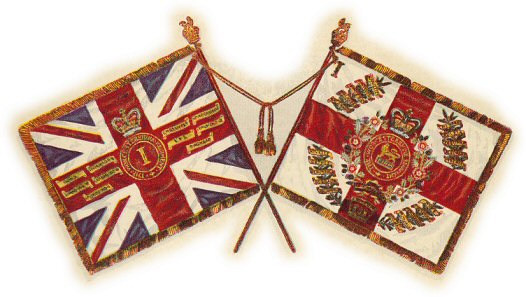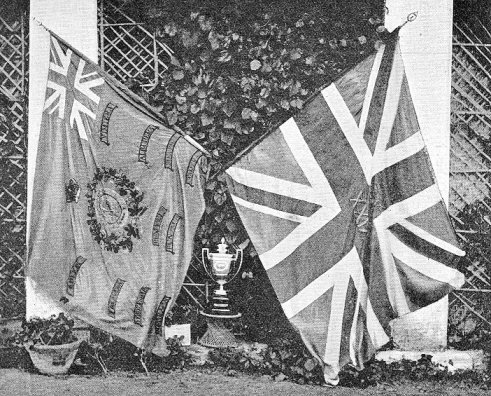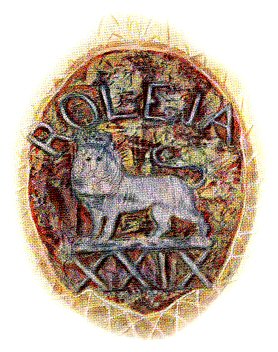The Colours
The Colours of the marching regiments of the British Army can trace their origin back beyond the date at which the Regular Army was first formed. Ensigns and flags of one kind or another had, of course, been used as rallying points in battle since the very dawn of history, and during the Middle Ages the armed forces of European chivalry displayed great numbers of standards, banners, bannerets and banneroles above their battle array; but those emblems were for the most part the personal insignia of the different feudal lords, followed and rallied to by his own personal followers. At the end of the Middle Ages the feudal levies were replaced all over Europe by formed bodies of professional soldiers trained in the use of the then novel firearms—those clumsy but effective arquebusses and musketoons which had sounded the knell of armour-plated knights—and the complicated heraldic bearings of of the proud old chivalry of Europe gave place to emblems bearing simple arrangements of colours chosen by the soldiers as the symbols of their companies; |
Colours of the 1st Battalion Worcestershire Regiment (1913-1960) |
for the new professional soldiers of the Sixteenth Century were essentially, even as our soldiers are to-day, free men engaging themselves willingly for pay, for adventure, or for honour alone, in place of the old feudal compulsion; and their company colours were then, as our Colours are to-day, the sign of their corporate association, the property of the unit as a whole. A visible symbol of this meaning of our Colours is the opening phase of the ancient ceremony of Trooping the Colour, when the Colour is in the hands of representatives of the rank-and-file and is entrusted by them to their officer.
For nearly a century after the general introduction of firearms (i.e. until about 1620) the new weapons remained so clumsy and slow-firing that large bodies of troops were difficult to manoeuvre; and consequently the individual company of about 100 men was the largest tactical unit, each company having its own Company Colour. Even when improvements in firearms and in drill led to the companies being first grouped and then definitely united under the "regiment" (or "rule") of individual Colonels, the strong sentiment of Company "esprit-de-corps" led to Company Colours being retained for many years; and right up to the time of Marlborough's Wars each battalion displayed a whole cluster of Colours—one for each of its ten Companies.
This multiplicity of Colours came to cause inconvenience on the battlefield, and in all armies Colours were gradually reduced in numbers, first to three and then to two per battalion. National flags were also coming into general use and recognition. Armies were ceasing to be collections of mercenary soldiers of fortune, and were gaining their present status as recognised representatives of the power of their country. For a time the old individuality of the independent regiments and their allegiance to their personal leader was expressed by an infinite variety of design in the regimental Colours, but eventually the national government asserted control, and definite regulations for Colours were laid down.
In our own Army this change took place in 1747. Previous to that date there had been definite regulations as to the Colours of the Regiments of Foot Guards, but none as to the Colours of Line Regiments, which had been entirely at the discretion of their Colonel. Such few details as still survive as to the Colours of this period show that there was then an extreme variety of design.
Unfortunately there seem to be no details available as to the design of the Colours carried by either Battalion of Worcestershire Regiment during this period. It was customary for the Colours to be of the same hue as the facings of the soldier's uniform, but this custom was not rigidly observed. The Colours were provided by the Colonel of the Regiment, in the same way as the clothing and other accoutrements—a system which was to continue for many years—and until about 1745 the various regiments were designated solely by their Colonel's names. As time went on, however, the consequent continual changes of nomenclature became inconvenient, the regiments began to acquire definite individuality of their own, and it was decided to allot them permanent designations by giving each regiment a distinctive number.
These new regimental numbers came gradually into use in the middle of the Eighteenth Century, and the change was crystallised by regulations issued in 1747, which laid down definite orders as to the Colours to be carried by each regiment. There were to be two Colours: the "King's Colour" and the "Regimental Colour" — the former "the Great Union" (or "Union Jack"), the latter to be "of the hue of the facings, with the Union in the upper canton." In the centre of each Colour was to be the number of the Regiment in gold Roman figures within a wreath of roses and thistles on one stalk.
The exact size of these Colours was also regulated — 6 foot deep on the staff and 6 foot 6 inches flying — practically four times the size of Colours of the present day. These huge Colours of old days were, however, proportionately lighter for their size, bearing very little embroidery and being without the heavy golden fringe which now decorates the emblems.
Colours of the 1st Battalion Worcestershire Regiment (Presented on 16th June 1841) |
From that date onwards the general pattern and appearance of the Colours of Worcestershire marching regiments remained unchanged for about a hundred years — all through the campaigns and expeditions of the Eighteenth Century and the great war which followed on the French Revolution. The form of the embroidery of the central device was elaborated towards the end of the Eighteenth Century, a decoration in the form of an ornamental shield being placed round the regimental number. In 1782 county titles were allotted to the majority of Line Regiments and presently these titles were placed on the Colours, at first on a scroll beneath the central device and later on a circle surrounding the regimental number. This latter practice began after Waterloo, and was definitely laid down in the regulations of 1844. Thenceforward the centre of the Colour was crimson, bearing the regimental number in gold within a crimson circle bearing the regimental title in gold letters. |
In 1801 came the legislative union of Great Britain and Ireland, and the "Union Jack" received the added cross of St. Patrick. This meant alterations both to the "Great Union" of the King's Colour and also to the small "Union" in the "upper canton" of the Regimental Colour. In addition the "Union wreath" on the Colours received an addition of shamrocks embroidered among its roses and thistles.
The practice of embroidering battle-honours on the Colours had not been general before the Peninsular War, although certain Regiments had been granted special permission to embroider honorary devices on their emblems; but during that war the custom became general, and thenceforward honours have been added to the Colours for each new campaign. Until 1881 very few regiments displayed battle-honours for wars before the French Revolution. In that year, however, a War Office Committee was given the task of deciding what battle-honours should be granted for the earlier campaigns of the Army's history. The selection made by that Committee was not very satisfactory, and in 1909 another Committee was appointed to do more justice to the hard fighting of the regiment in early wars; but that Committee ceased to function in August 1914, with its task yet uncompleted, and consequently many possible battle-honours were still missing from the Colours of the old regiments of the Line.
Up till 1845 the honours, distinctions, and badges of each regiment were borne on both the King's and the Regimental Colour; but in that year, presumably for economy, orders were issued that in future these Regimental distinctions should be borne only on the Regimental Colour, the King's Colour thenceforward being plain except for the number and title of the Regiment.
In the Crimean War of 1854-55 the British Regiments went into action still carrying the huge Colours of the old regulation size, which had not been changed since 1747:- 6 foot on the pole and 6 foot 6 inches flying; but it was found that the increasing accuracy of firearms made the honourable duty of the ensigns not only dangerous but positively suicidal. The French, who fought alongside us, carried smaller Colours, and, after the war was over, regulations were issued in 1857 reducing the size of the Colours to 5 foot 6 by 6 foot. Further reductions in size followed — in 1859 to 3 foot 6 inches by 4 foot, and in 1862 to 3 foot by 3 foot 9 inches, at which size Colours have remained until the present day. Another innovation copied from Continental practice was the introduction in 1859 of gold fringes to the Colours; previously in the British Army fringes had only been borne on the standards and guidons of the Cavalry. Another change which was made at the same time was in regard to the head of the staff of the Colours. Originally the Colours of the marching regiments had been displayed on a plain pike — the simple shaft of wood topped by a spearhead which was the favourite weapon for hand-to-hand fighting in the Sixteenth and Seventeenth Centuries before the invention of bayonets, and whose simple design gave rise to the phrase "as plain as a pikestaff." So the original staff of British regimental Colours was topped by a businesslike steel spearhead with which the Ensign could at the last resort defend himself and his charge from capture. |
Colours of the 1st Battalion Worcestershire Regiment (1872) |
But in practice the huge unwieldy Colour must have made its pike singularly difficult to handle as a weapon, and towards the end of the Eighteenth Century the practice seems to have crept in of substituting for the spearhead a decorative top to the Colour, still of spear-shape, but pierced and ornamented and (presently) of gilt metal. Then we encountered the French armies of Napoleon with their battle-flags topped with eagles; and several of the British regiments began (unofficially) to follow suit. One or two of the regiments which had been granted the Sphinx badge for service in Egypt placed solid silver sphinxes on the top of their Colour poles, and the old 29th had made a pair of solid gilt Lions which, as recorded by Colonel Everard, were screwed on to the top of the poles on all occasions of ceremony in place of the regulation "spear-head." This was, however, quite unofficial, and the "spearhead" shape remained regulation until 1868, when the Royal Crest — the Lion and Crown — which is now regulation for all Standards and Colours, was formally introduced.
In 1881 there took place the general reorganization of the British Infantry, by which the old numbers were swept away and the old numbered Line regiments were combined in pairs to form new County regiments. The change was violently unpopular, not least because it entailed many changes in the old and hallowed designs of Regimental Colours.
It was decreed that the old time-honoured distinctive regimental facings should disappear and with them the distinctive hue of the Regimental Colours, that all English regiments should have white facings and should carry white Colours with a red St. George's Cross, that the battle-honours won by both the regular battalions of a regiment should be displayed on the Colours of both battalions, and that the old Regimental number should disappear from the centre of the Colours and should be replaced by the Battalion number of the new County Regiment, except in the case of such few regiments as had special permission to display a badge in the centre of their Colour. That latter distinction had been sparingly accorded, and very few regiments had displayed badges in the centre of their Colours before 1881. The reason for this originally was undoubtedly probably merely utilitarian. The waving Colours were the quickest and easiest way to recognise and identify a regiment amid the smoke of battle, and a general or aide-de-camp could most easily see the identity of the unit if its number was prominently displayed in the centre of the Colour. Consequently the original regulations of 1747 only authorised such badges to be displayed as were already familiar by a generation of use, and which consequently were even more easily recognizable than the then new regimental numbers. Only a few favoured regiments had been allowed to place badges in the centre of their Colours between 1747 and 1881, and a general feeling had grown up that to have a badge in the centre of the Colour was a high honour. It is true that, as the existing fragment of that Colour shows, Worcestershire Regiment "Royal Lion" badge had been borne in the centre of the Colours of the 29th during the Peninsular War; but unfortunately no record survives of the original grant of that distinction, and afterwards the badge was not included in the new Colours issued to the 29th in 1812 to replace those shot to pieces in the Peninsular War. As no effort was made during the intervening years to claim the Lion badge, in 1881 the Colours of the Regiment, like those of most other English regiments of the Line, were allowed to have nothing but the Battalion number in the centre of the design. |
The Lion Badge from the centre of the |
That unimaginative regulation was unfortunate, because other changes at that time tended to emphasise the concentric nature of the Colours' design. The small "Union" hitherto embroidered in the upper corner of the Regimental Colour was omitted from new Colours issued after 1881, and also by a happy inspiration the authorities introduced a circular laurel wreath into the design to bear the scrolls of the battle-honours, which had in all cases been considerably agumented by the amalgamation of the honours of two old regiments (29th and 36th Foot) into one.

The Colours of the 1st Battalion Worcestershire Regiment presented by General Sir Richard N. Gale, G.C.B., K.B.E., D.S.O, M.C
(At Worcester on the 16th July 1960)




